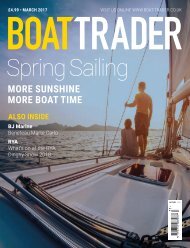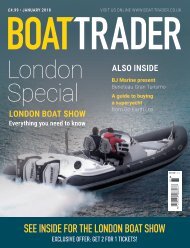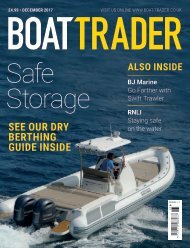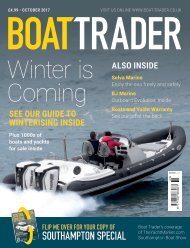Create successful ePaper yourself
Turn your PDF publications into a flip-book with our unique Google optimized e-Paper software.
BOAT TRADER ADVERTORIAL<br />
DIFFERENT TYPES<br />
Open style sport<br />
motor yachts<br />
Sailing Boats<br />
Catamarans<br />
Open style sport motor yachts are very<br />
common, have a maximum of two decks but<br />
can be very spacious and luxurious. These<br />
vessels are, generally, fast so you can cut down<br />
on journey time, but also have the refinements<br />
needed <strong>for</strong> entertaining guests with plenty of<br />
space <strong>for</strong> sunbathing and dining.<br />
They’re the perfect type of vessel <strong>for</strong> getting<br />
into those secluded bays and deserted beaches;<br />
they’re easier to manoeuvre into marinas –<br />
worth thinking about if you are inexperienced<br />
at the helm. They come with a choice of engine<br />
sizes, so you need to think carefully about what<br />
kind of sailing you’ll be doing, as the engine<br />
size and the amount of rpm will have a huge<br />
bearing on fuel consumption. Hybrid systems<br />
are starting to be seen on some big yachts and<br />
the technology is getting better all the time, so<br />
it’s only a matter of time be<strong>for</strong>e such systems<br />
will be found on smaller yachts.<br />
The type of propulsion you choose can include:<br />
outboard, inboard shaft drive, sail drive,<br />
stern or surface drive, Pods or jet drive, all<br />
have advantages over one another in certain<br />
situations. You can have stern thrusters fitted<br />
if you want total control, although they won’t be<br />
needed if the vessel has pod drives. Something<br />
to consider if you’re likely to have people on<br />
board who might not be good with a rocking<br />
boat is stabilization. You can get stabilization<br />
<strong>for</strong> boats from 30’ up in length that can be<br />
retro fitted or added during construction.<br />
Stabilization is useful while underway to help<br />
reduce boat motion, relieving some symptoms<br />
of seasickness.<br />
56<br />
Sailing boats come in three different hull<br />
types; monohull, twin hull (Catamaran) or<br />
triple hull (Trimaran). Mono hull yachts are<br />
the most common. Then there is the type of<br />
Mast and Sails you require: A cat is a small<br />
boat with one Mast far <strong>for</strong>ward near the<br />
Bow with one Sail. A sloop has one mast<br />
and two sails, and then there is a Cutter,<br />
which still has one Mast but three sails.<br />
A Ketch will have a second shorter Mast aft<br />
of the main near the Transom, A Schooner<br />
usually only have two masts, but can have<br />
more, in a two mast configuration the aft<br />
mast is taller than the main.<br />
Most sailboats have a Fin Keel, which varies<br />
in design, some with wings (to help reduce<br />
draft) or a heavy bulb (which lowers the<br />
centre of gravity, making it more efficient<br />
without increasing its length). Then there<br />
are Bilge Keels or twin keels, these are set<br />
off to either side of the hull, as opposed to<br />
the centre like the Fin type.<br />
They are not so good at reducing slippage,<br />
however, so you need to be more aware in<br />
heavy winds. There is also a Full-Length<br />
Keel, usually found on older boats.<br />
Sailboats usually come with a single engine,<br />
very useful <strong>for</strong> getting in and out of marinas<br />
and when there’s no wind whilst underway.<br />
Depending on the boat’s size, you’ll find<br />
it will either have a tiller connected to<br />
the rudder or it will have up to two large<br />
steering wheels connected to the rudder.<br />
Catamarans are boats made up of two<br />
hulls. This type of boat is becoming more<br />
and more popular mainly because of the<br />
extra room you get both inside and on<br />
deck.<br />
They are usually two decks, although some<br />
larger ones can have three, and come in<br />
both motor and sail versions in various<br />
sizes.<br />
It is said, and proven through tests, that<br />
they are unsinkable (where have we heard<br />
that be<strong>for</strong>e?). They are also very difficult to<br />
capsize and if you are unlucky enough to<br />
have this happen at least it wont sink, so<br />
you can use it as a life raft.<br />
The disadvantage of them compared to a<br />
monohull if capsized is with a monohull, if<br />
you catch it quick enough be<strong>for</strong>e it sinks,<br />
there is a good chance of re-righting the<br />
boat, whereas with a catamaran you have<br />
no chance of getting it back sunny side up.<br />
It has to be said though they are faster,<br />
under sail, than a monohull in the same<br />
wind because of less resistance from<br />
the hull, and they don’t need a large<br />
keel hanging down beneath the water to<br />
counter the sails.<br />
Because of the twin hull design they don’t<br />
heel when under sail like a monohull does<br />
and tend to sail quite flat, which has it’s<br />
advantages but does make it a bit more of<br />
a handful when tacking and you have to be<br />
careful not to overload the sails.







